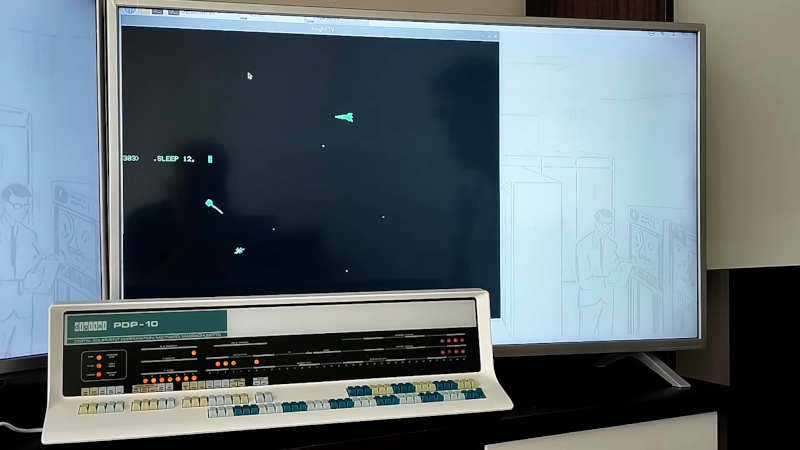[Oscar] at Obsolescence Guaranteed is well-known for fun replicas of the PDP-8 and PDP-11 using the Raspberry Pi (along with some other simulated vintage computers). His latest attempt is the PDP-10, and you can see how it looks in the demo video below.
Watching the video will remind you of every old movie or TV show you’ve ever seen with a computer, complete with typing noise. The PDP-10, also known as a DECsystem-10, was a mainframe computer that usually ran TOPS-10. These were technically “mainframes” in 1966, although the VAX eclipsed the system. By 1983 (the end of the PDP-10’s run), around 1,500 had been sold, including ones that ran at Harvard, Stanford, Carnegie Mellon, and — of course — MIT. They also found homes at CompuServe and Tymshare.
The original 36-bit machine used transistors and was relatively slow. By the 1970s, newer variants used ICs or ECL and gained some speed. A cheap version using the AM2901 bit-slice CPU and a familiar 8080 controlling the system showed up in 1978 and billed itself as “the world’s lowest cost mainframe.”
The Knight terminals were very unusual for the day. They each used a PDP-11 and had impressive graphics capability compared to similar devices from the early 1970s. You can see some of that in the demo video.
Naturally, anyone who used a PDP-10 would think a Raspberry Pi was a supercomputer, and they wouldn’t be wrong. Still, these machines were the launching pad for Adventure, Zork, and Altair Basic, which spawned Microsoft.
The cheap version of these used bitslice which we’ve been talking about lately. [Oscar] is also known for the KIMUno, which we converted into a COSMAC Elf.

















My first computing classes and practice were done coding FORTRAN in a PDP 11/23. I barely missed writing my code in 80-column cards just because the card reader (an IBM machine) was out of order at the moment so the admin tweaked the machine to let 8 people at a time, working with just 8K of memory for all of us. I can’t say I miss that.
Later I gained access to the Graduate Center’s ICL midrange to code in BASIC. I felt I was The Shit since the terminals were touchscreens. A matrix of infrared LEDs but touchscreen nonetheless.
On second thoughts I should have applied myself more. One of my first problems to solve was matrix multiplication.
DEC-10s were very popular with the early AI crowd of the 1970s. I saw one at MIT when I visited there in the mid-70s and I briefly had an account on ARPANET host MIT-AI which I *think* was a DEC-10. Also, I know someone who actually had a DEC-10 in his living room. He had gotten it as surplus.
It was more than 1,500. Based on serial numbers:
KA10: a few hundred. KI10: also a few hundred. KL10: a few thousand. KS10: a few hundred.
So by a rough estimate, around 4000 maybe?
Oscar’s kits so far (PiDP-8, PiDP-11) have been great – well designed, solid builds that require minimal tools and only basic soldering skills. They are a bit expensive, but now that RPi boards are readily available I’d encourage anyone interested to seriously consider ordering a kit.
For those who aren’t interested in assembling their ‘system’, the PiDP-10 (discussed here) is available pre-assembled for an additional fee (1/3rd premium over the unassembled kit).
I think it is hardly possible to overestimate the role that the real PDP-10 played in the history of computing and computer science back in its days.
Interactive time sharing operating systems, artificial intelligence, wide area computer networks, computer gaming, popular tools (to this day) like EMACS, the LISP programming language, the “culture” of free and open software … all these saw major advancements during that time, and often with the help of the PDP-10 at MIT and elsewhere.
If you buy a PiDP-10 kit, perhaps consider getting a copy of “Hackers” https://en.wikipedia.org/wiki/Hackers:_Heroes_of_the_Computer_Revolution to go along with it so you can immerse yourself in the culture that led to the development of the ITS operating system that ran on the PDP-10 and is simulated as one OS option on the PiDP-10 kit.
Is my imagination or does that guy have big hands?
May have to get one of these. I have the 1/3 scale PDP 11/70 and enjoy it. Just upgraded it to a RPI5 from a 4. I use it for more than just a PDP simulator. A pi-hole, redis server, and other things working in the background. A computer just seems more ‘real’ if it has a bunch of lights blinking away with switches!